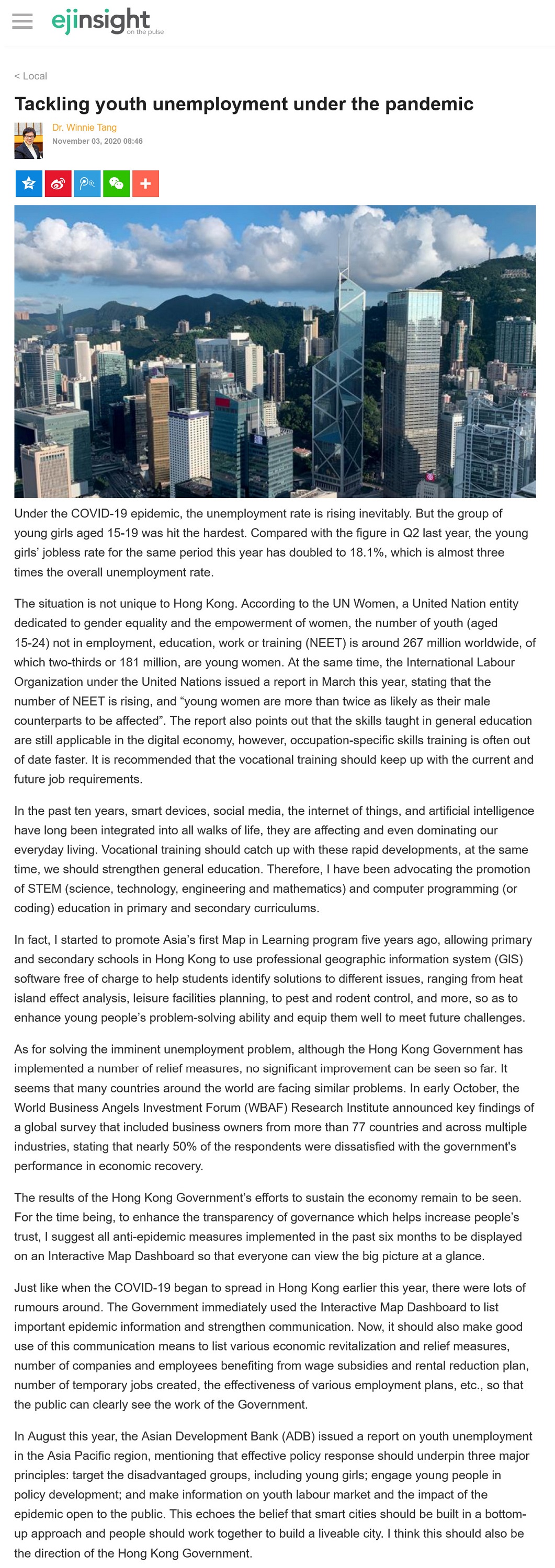網上版請按此

Tackling youth unemployment under the pandemic
Under the COVID-19 epidemic, the unemployment rate is rising inevitably. But the group of young girls aged 15-19 was hit the hardest. Compared with the figure in Q2 last year, the young girls' jobless rate for the same period this year has doubled to 18.1%, which is almost three times the overall unemployment rate.
The situation is not unique to Hong Kong. According to the UN Women, a United Nation entity dedicated to gender equality and the empowerment of women, the number of youth (aged 15-24) not in employment, education, work or training (NEET) is around 267 million worldwide, of which two-thirds or 181 million, are young women. At the same time, the International Labour Organization under the United Nations issued a report in March this year, stating that the number of NEET is rising, and "young women are more than twice as likely as their male counterparts to be affected". The report also points out that the skills taught in general education are still applicable in the digital economy, however, occupation-specific skills training is often out of date faster. It is recommended that the vocational training should keep up with the current and future job requirements.
In the past ten years, smart devices, social media, the internet of things, and artificial intelligence have long been integrated into all walks of life, they are affecting and even dominating our everyday living. Vocational training should catch up with these rapid developments, at the same time, we should strengthen general education. Therefore, I have been advocating the promotion of STEM (science, technology, engineering and mathematics) and computer programming (or coding) education in primary and secondary curriculums.
In fact, I started to promote Asia's first Map in Learning program five years ago, allowing primary and secondary schools in Hong Kong to use professional geographic information system (GlS) software free of charge to help students identify solutions to different issues, ranging from heat island effect analysis, leisure facilities planning, to pest and rodent control, and more, so as to enhance young people's problem-solving ability and equip them well to meet future challenges.
As for solving the imminent unemployment problem, although the Hong Kong Government has implemented a number of relief measures, no significant improvement can be seen so far. It seems that many countries around the world are facing similar problems. In early October, the World Business Angels Investment Forum (WBAF) Research Institute announced key findings of a global survey that included business owners from more than 77 countries and across multiple industries, stating that nearly 50% of the respondents were dissatisfied with the government's performance in economic recovery.
The results of the Hong Kong Government's efforts to sustain the economy remain to be seen. For the time being, to enhance the transparency of governance which helps increase people's trust, I suggest all anti-epidemic measures implemented in the past six months to be displayed on an Interactive Map Dashboard so that everyone can view the big picture at a glance.
Just like when the COVID-19 began to spread in Hong Kong earlier this year, there were lots of rumours around. The Government immediately used the Interactive Map Dashboard to list important epidemic information and strengthen communication. Now, it should also make good use of this communication means to list various economic revitalization and relief measures, number of companies and employees benefiting from wage subsidies and rental reduction plan, number of temporary jobs created, the effectiveness of various employment plans, etc., so that the public can clearly see the work of the Government.
In August this year, the Asian Development Bank (ADB) issued a report on youth unemployment in the Asia Pacific region, mentioning that effective policy response should underpin three major principles: target the disadvantaged groups, including young girls; engage young people in policy development; and make information on youth labour market and the impact of the epidemic open to the public. This echoes the belief that smart cities should be built in a bottom-up approach and people should work together to build a liveable city. I think this should also be the direction of the Hong Kong Government.
Dr. Winnie Tang
Adjunct Professor, Department of Geography, Faculty of Social Sciences and Faculty of Architecture, The University of Hong Kong